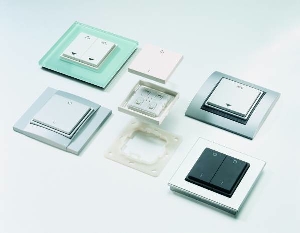A lot of energy is wasted through forgetfulness and carelessness by humans. For example, we forget to turn off the lights when leaving a room or to turn off the television after watching. These are some of the ways through which valuable energy resources are wasted.
 EnOcean's self-powering sensors -- found inside these switches -- can now communicate via TCP/IP, eliminating the need for pesky wires
EnOcean's self-powering sensors -- found inside these switches -- can now communicate via TCP/IP, eliminating the need for pesky wires
The Chairman of EnOcean, Graham Martin commented on the absence of automation systems in buildings. Such systems can help cut down energy wastage. To address these issues, EnOcean has designed self-powered sensors that harvest energy and can be easily fitted inside switches and thermostats, manufactured by the company. Communication between such sensors happens through TCP/IP networks, which control the devices through an external device connected through the Internet. EnOcean concentrates on creating low-cost devices that consume less power and communicate via wireless networks.
When an EnOcean switch is used to turn on a light, sufficient energy is generated that is capable of sending out a wireless signal through TCP/IP network onto a wireless receiver. Through the latest technology, any computer that is connected to the internet can communicate with the sensors. The sensors can be installed easily since they are of the peel-and-stick type. They are self-powered devices, which draw energy from solar cells, linear and thermal motion converters and energy thus generated is sufficient for transmission of a wireless signal.
After the sensor has been installed, a gateway device, which is similar to a router, needs to be set up. The sensors then communicate through this gateway device and transmit data through the internet server. After installing applications such as VenergyUI or Can2Go on Android or iPhones, one can access the data from the server and control the devices based on the values read from the data.
EnOcean has successfully installed switches in more than 100,000 buildings for energy saving measures and is looking at widening the scope of application in college dorms and hospitals.